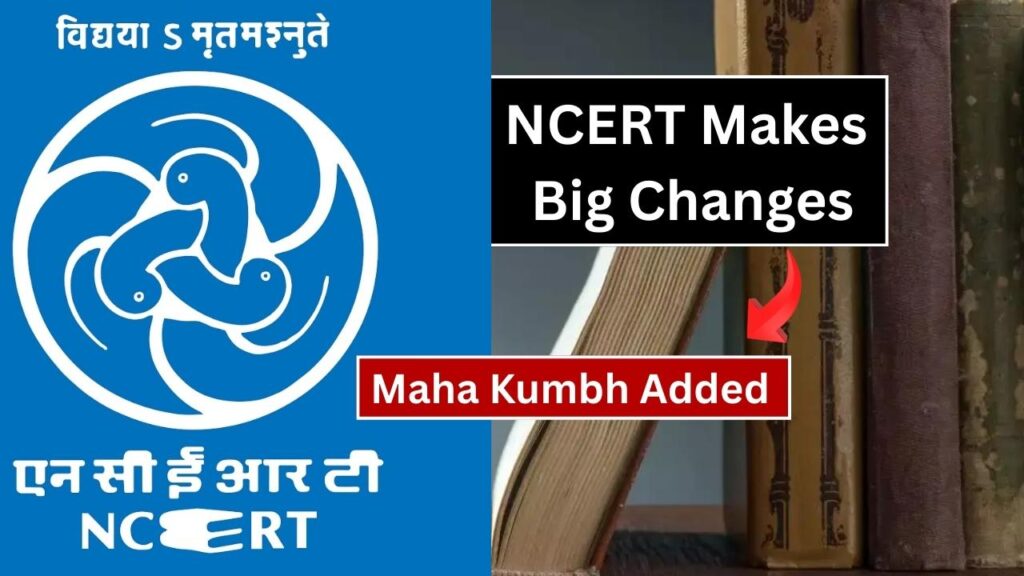NCERT Makes Big Changes: The National Council of Educational Research and Training (NCERT), which is responsible for designing school curricula in India, has recently made some major changes to Class 7 textbooks. Two significant chapters—the Mughals and the Delhi Sultanate—have been removed, and in their place, a new section on the Maha Kumbh has been introduced.

This change has sparked a lot of debate across the country, especially regarding the removal of such key historical periods from the curriculum. This article delves into the reasons behind these changes, the potential implications, and how educators and students can navigate these shifts.
NCERT Makes Big Changes
| Topic | Details |
|---|---|
| Curriculum Changes | Mughals and Delhi Sultanate removed from Class 7 textbooks; Maha Kumbh added. |
| Reason for Changes | Streamlining the curriculum and focusing on cultural and religious events. |
| Impact on Students | Students may lose exposure to important historical periods, but gain insight into cultural heritage. |
| Practical Advice | Teachers should adapt by focusing on other historical resources and exploring the Maha Kumbh topic deeply. |
| Official Source | NCERT Official Website |
The removal of the Mughals and the Delhi Sultanate chapters from the Class 7 textbooks, while controversial, is part of a broader effort to update the curriculum in a way that reflects contemporary needs and cultural relevance. The introduction of the Maha Kumbh offers an opportunity for students to learn about one of the world’s largest spiritual gatherings and understand its importance in the cultural and religious landscape of India. Educators can embrace these changes by supplementing historical content and focusing on engaging ways to present new topics, ensuring that students remain connected to their heritage in a meaningful way.
What Led to the Changes?
The National Curriculum Framework (NCF) of 2023, which guides the direction of textbooks in India, emphasizes a move towards incorporating more diverse and inclusive content. With a focus on making history more relatable to students, the NCERT has opted to remove topics that have often been seen as contentious or difficult for young learners to grasp. The Mughals and the Delhi Sultanate are two such chapters that have been part of the curriculum for years but are now being seen as areas that can be explored in more detail in higher grades.
At the same time, the inclusion of the Maha Kumbh, one of the largest and most significant religious gatherings in India, is a move to emphasize the nation’s rich cultural and spiritual heritage. The festival, which brings together millions of people every 12 years to bathe in the holy river, symbolizes India’s diversity and offers an opportunity to teach students about the significance of cultural practices.
Understanding the Mughals and the Delhi Sultanate
For centuries, the Mughals and the Delhi Sultanate shaped the Indian subcontinent in many ways. The Delhi Sultanate (1206–1526) laid the groundwork for the Mughal Empire (1526–1857), which brought about a period of cultural fusion, monumental architecture, and the development of arts and literature.
For instance, the Mughal emperor Akbar is well-known for his policy of religious tolerance and efforts to integrate different cultures. The Taj Mahal, an iconic symbol of India, was built during the Mughal reign. The Delhi Sultanate, on the other hand, is crucial in understanding the transition of India from regional kingdoms to a more centralized political structure, influencing everything from governance to society.
Despite their historical importance, these periods can be complex for young learners. The NCERT has chosen to streamline this material and introduce it in later grades where students can better grasp the significance of these empires.
Why Maha Kumbh Was Added
The Maha Kumbh is a unique cultural and spiritual event that takes place every 12 years at one of four sacred riverbanks in India: Allahabad (Prayagraj), Haridwar, Nashik, and Ujjain. It is a major Hindu pilgrimage and one of the largest peaceful gatherings in the world. The event is a symbol of India’s diverse religious and cultural practices and offers a rich opportunity to teach students about the significance of water, rituals, and community in Hinduism.
The addition of Maha Kumbh to the curriculum is an effort to bring more practical and engaging content to students. It provides an opportunity for them to learn about the deep cultural and spiritual heritage of India. In an increasingly globalized world, understanding such traditions helps students connect more with their country’s values and history.
How Does This Impact Students and Teachers?
The removal of the Mughals and the Delhi Sultanate chapters could result in a gap in historical knowledge for students who are now exposed to less information about these key periods. However, educators can address this by integrating other resources—books, documentaries, and online content—that provide a deeper understanding of these topics.
On the other hand, the introduction of Maha Kumbh provides teachers with an exciting opportunity to teach students about religious practices, the significance of major festivals, and the cultural diversity of India. By using storytelling, multimedia tools, and first-hand accounts, educators can bring this topic to life in the classroom.
Here are some practical steps teachers can take to adapt to this change:
- Supplement Historical Knowledge: Although the Mughals and Delhi Sultanate chapters are removed from the syllabus, teachers can recommend supplementary reading materials to students. Books, documentaries, and articles on these periods can enrich students’ understanding.
- Engage with Maha Kumbh: Teachers can use this opportunity to explore the Maha Kumbh not only from a religious perspective but also from a sociocultural angle. They can invite guest speakers, use multimedia, and encourage students to research and present their findings.
- Incorporate Discussions: Use the curriculum change as a conversation starter. Encourage students to reflect on the importance of festivals like Maha Kumbh and how they relate to contemporary India.
- Leverage Digital Tools: In today’s tech-savvy world, teachers can use online platforms and resources to expand on topics. For example, virtual tours of the Maha Kumbh festival or historical sites related to the Mughals can enhance learning.
The Cultural Shift: A Deeper Look at the Maha Kumbh
The Maha Kumbh is more than just a religious festival; it is a testament to India’s ancient traditions. The festival involves the ritual of bathing in the holy river to cleanse oneself of sins and attain spiritual salvation. The event is marked by various religious and cultural performances, and millions of pilgrims from all walks of life gather to participate.
The symbolism of the Kumbh (a sacred pitcher of water) comes from Hindu mythology, where it is said to contain nectar that grants immortality. The festival is thus a celebration of life, spirituality, and community.
For students, learning about the Maha Kumbh offers an opportunity to understand how festivals are an integral part of India’s cultural fabric. It provides insight into the religious significance of water, the importance of pilgrimage in Hinduism, and the unity that these festivals bring to people across the country.
Madras University IDE Results 2024: UNOM Distance Learning UG PG Semester Result
Opportunity Knocks: Rajasthan Police Recruiting 9,617 Constables – Applications Open April 28!
New JEE Advanced Syllabus 2025 Released — Key Topics That Can Skyrocket Your Score
FAQs About NCERT Makes Big Changes
Q: Why were the Mughals and the Delhi Sultanate removed from the Class 7 syllabus?
A: The NCERT has streamlined the curriculum to make it more focused on the needs of modern students. The Mughals and Delhi Sultanate are complex topics that will now be taught at a later grade when students are better equipped to understand them.
Q: What is the Maha Kumbh and why is it being added to the curriculum?
A: The Maha Kumbh is a major Hindu religious gathering that takes place every 12 years. It is being added to the curriculum to highlight India’s diverse cultural and spiritual practices, giving students a deeper understanding of the country’s heritage.
Q: How can teachers adapt to these changes in the syllabus?
A: Teachers can supplement the removed chapters with additional resources like books and documentaries on the Mughals and Delhi Sultanate. They can also delve deeply into the Maha Kumbh topic using multimedia tools, guest speakers, and hands-on activities to engage students.
Q: Will these changes affect students’ understanding of Indian history?
A: While the changes may result in less focus on the Mughals and Delhi Sultanate in Class 7, these periods will still be covered in higher grades. In the meantime, the addition of the Maha Kumbh offers an enriching cultural experience for students.








